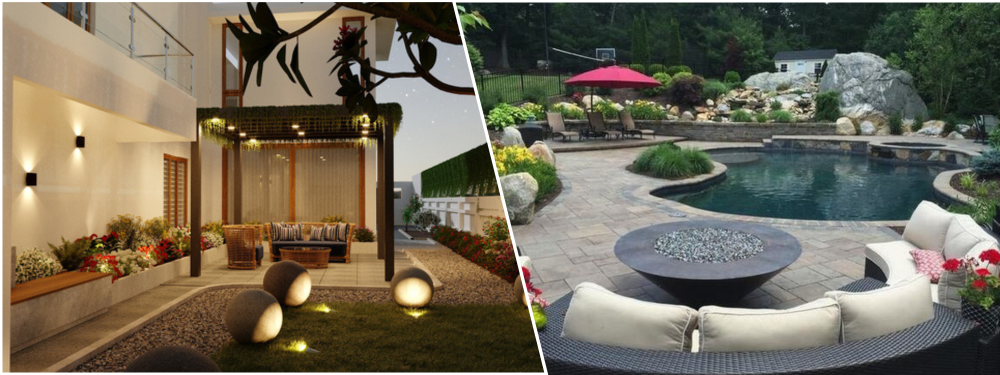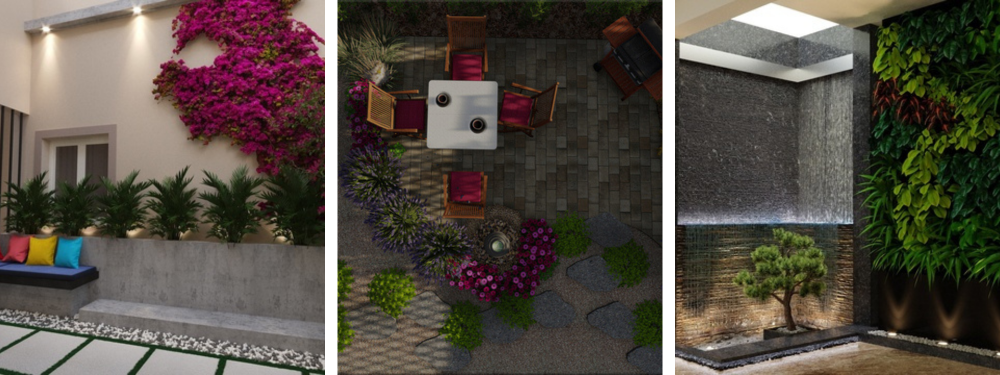Much like the construction project of any part of a building, 3D CAD in 3D landscape design simplifies planning and execution. Traditionally, the blueprint in landscape design is drawn in 2D and presented on physical paper or PDF. Size and space are the key elements in a two-dimensional drawing, which illustrates the overall flow of features in a landscape from a bird’s eye view.
Think of it as a typical floor plan, but the image represents an outdoor space rather than the interior. Since the main building and the surrounding area are also illustrated, the plan should show the amount of space the project takes and how the newly constructed area connects to nearby structures. The drawing might contain some technical information or annotation about unperceivable dimensions like thickness and height.
A 3D landscape design illustrates all features—including fabricated structures and plants—in a realistic digital image. Instead of viewing the project from an overhead perspective, a three-dimensional view offers a comprehensive, lifelike visualization.
It is a 3D architectural modeling service and rendering focused on the landscape area. The renderings often include partial views of the main building as reference points to determine the project scale. Realistic visualization conveys a more precise sense of dimension and depth, offering homeowners better confidence in giving feedback and approval.
Depending on the project size, a 3D landscape design illustrates the following features:
- Trees, flowers, and shrubs
- Custom decks
- porches
- Pavilions
- Pergolas
- Outdoor pool
- Outdoor kitchens
- Walkways
- Patios
- Outdoor fireplaces
- Landscape Lighting
A CAD artist usually draws a 3D landscape design based on the plan provided by a landscape designer or landscape architect. A homeowner may hire either professional to oversee the planning and construction.
3D Landscape rendering services workflow
Design and visualization are two different things. The design phase is the earliest step in a landscaping project, and it is the portion where architects or designers gather as much information about the project as possible. They can guide homeowners (during the initial consultation) about what to expect from a given budget range, timeline, and terrain characteristics.
Homeowners often have unrealistic investment expectations, but experienced professionals can assess what is feasible based on site survey challenges. For instance, improving soil conditions may be necessary for specific plant species or adjusting the area size to accommodate desired structures. Once constraints are identified, a well-informed design decision is made, and two-dimensional drafts are created for the homeowner.
If no revisions are necessary for the 2D draft, architects commission CAD design experts to draw a realistic visualization of the plan in 3D. While homeowners can use free online tools to illustrate the project independently, the result might need to be more usable for contractors who oversee the construction. The images must correspond with the approved draft and technical documents for the contractor bidding process. We can safely assume that the 3D visualization accurately captures the final form.

RELATED: Hire a Landscaping Architect for CAD Drafting & Design Work
Landscape architect Vs. Landscape designer
Although both professions focus on landscaping, they have different scopes of work and qualifications. “landscape architecture” is a broad concept that describes designing outdoor areas to achieve environment-friendly aesthetic outcomes. The practice involves the analysis of soil conditions and ecological processes and the construction of various structures to help sustain the surrounding ecosystem.
On the other hand, landscape design focuses on creating mutual interaction between humans and nature by arranging features in open spaces like gardens and parks. This includes 3D landscape rendering design services wherein the images used are generally meant to be as photorealistic as possible to convey the overall look of a landscape to a customer or client.
Landscape architects
They are the mastermind behind the sustainability, functionality, practicality, usability, and ecological aspects of artificial or “human-made” outdoor areas. Landscape architects envision the best composition for open spaces and use their problem-solving skills to craft a practical road map to materialize the ideas.
Most landscape architects work on high-budget projects involving multiple stakeholders. However, some professional freelancers are also willing to cater to residential clients. They are responsible for drafting landscape master plans, choosing the types of materials for fabricated structures, and determining the most effective construction methods. Landscape architects often work with contractors, suppliers, and designers, too.
Landscape architects go beyond the role of landscape designers, handling technical drawings, permits, and bidding documents, including 3D architectural site plan rendering services. Their expertise in material characteristics and structural components drives design decisions based on environmental impacts and sustainability. They excel in large-scale projects like urban greenery regeneration, parks, and corporate gardens.
In the US, “landscape architect” requires a Bachelor’s and Master’s degree, state license, and ASLA-accredited education. In the UK, recognition from LI is needed. Licensed landscape architects offer services for outdoor spaces, including waterfront developments, resorts, parks, and commercial centers. They lead restoration projects in forests, mines, streams, and wetlands, preserving historical greeneries.
RELATED: Learn About In-Ground Swimming Pool Design Costs & Drafting Services Rates
Landscape designer
Every landscape architect can be a landscape designer, but not vice versa. That said, the latter is more of an all-rounder profession, from working with architects and clients to reading technical blueprints and getting hands-on with the plan execution.
No degree requirement for landscape designers; it’s a self-taught vocation. To be a professional, studying relevant courses in college or online is recommended for a solid foundation and project-handling skills.
The course programs should include lessons about the specific roles of landscape designers in any project and instructions about technical matters, such as calculating the cost of a project, creating a plan from scratch, and reading an architect’s plan. A landscape designer has to know how to select materials, plant species, furniture pieces, and features. Managerial skills like budgeting and scheduling are also necessary.
Some designers have the same levels of training as architects; quite a few have obtained undergraduate or graduate degrees in landscape architecture too. The most significant difference is that landscape designers must be licensed to offer freelance landscape design services as an architect. Unlike most design-related occupations, the ability to make technical drawings is not a prerequisite.
What about a landscaper?
Despite sounding similar, a landscape designer is different from a landscaper. The former interprets an architect’s plan and oversees its implementation, while the latter is the person who physically builds the space. The job description of a landscaper may consist of installing/building structures like pergolas, fencing, decking, and paving.
There is no formal educational program for landscapers on a residential scale, unlike landscape design experts or architects. Most of them are trained on the job, but seeking qualifications in Garden Design for working on commercial or larger projects might be helpful.

RELATED: What does it Cost to Hire a Landscape Design Architect Expert for your Company?
3D Landscape design cost
Every landscape is different, and so is the visualization complexity. Most architectural 3D exterior rendering services projects are priced between $150 and $700, with a week or less turnaround time, and the price does not include the planning and the actual construction.
Despite the differences between landscape architects and designers, the cost of hiring their services is quite similar. The hourly rate for designers tends to fall between $50 to $150 per hour, while an architect typically charges $70 to $150. If someone hires an architectural firm instead of a freelance professional, and the chief architect handles the job, the rate can go up to $200 per hour. A landscape project overseen by a designer tends to run for more extended periods, resulting in a higher cost overall.
Some landscape architecture designers offer a per-square-foot pricing structure for projects of all complexity levels. The average pricing structure is as follows:
| Project Complexity | Cost per square foot | Overall Project Cost |
| Low-end | <$70 | <$50,000 |
| Midrange | $70 – $140 | $50,000 – $100,000 |
| High-end | $140 – $200 | $100,000 – $400,000 |
| Luxurious | >$200 | >$400,000 |
A low-end project is a basic yard design construction in a relatively small area that does not use exotic materials or rare plant species. High-end landscaping typically involves the installation of multiple features, such as outdoor kitchens, decks, in-ground pools, and patios. The pricing does not cover the initial consultation fee, which can cost around $50 per hour, whether with a designer or architect.
How Cad Crowd can help
If you’re looking for expert CAD design services, look no further than Cad Crowd. With a team of skilled designers and engineers, Cad Crowd can help you bring your ideas to life precisely and efficiently. Make sure to settle for more regarding your design projects – trust Cad Crowd to deliver the desired results. Contact us today for a free quote to get started!
